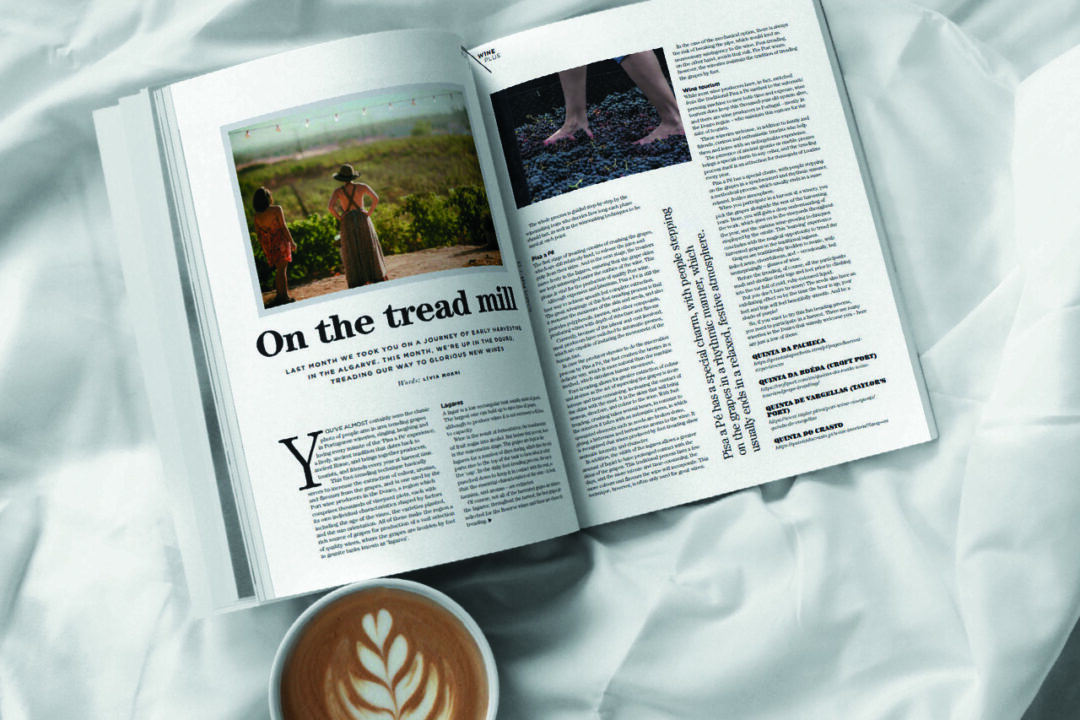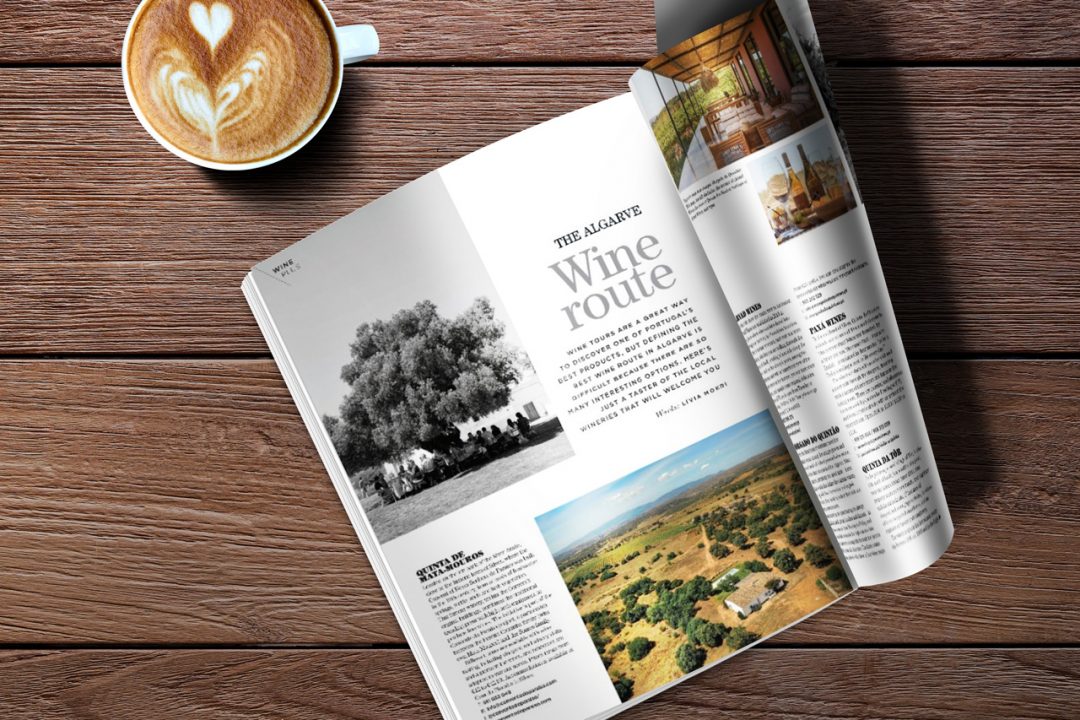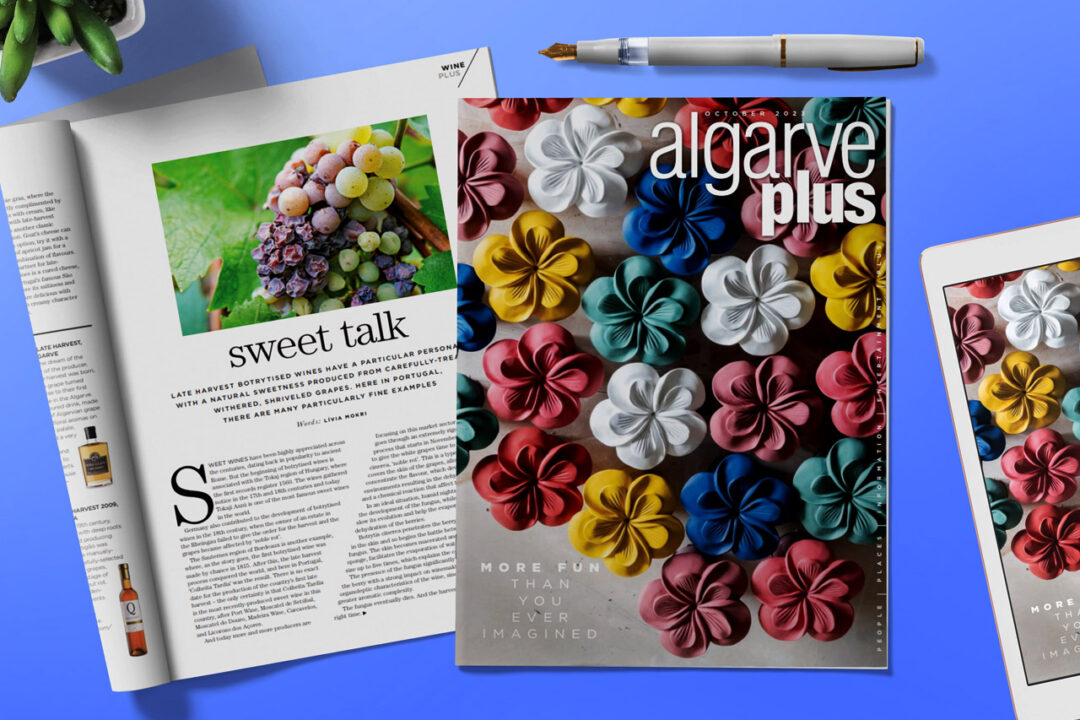KNOW YOUR ORANGES – In Portugal, November is also the month of the opening of the Talhas and tasting the new orange wines made in amphoras.
Orange wine is a bit of a misnomer – there are no oranges involved in its making. It’s a type of white wine made by leaving the grape skin and seeds in contact with the juice, creating an orange-hued finish.
Here in Portugal, these wines are also called Vinho de Curtimenta.
In my new writing, I talk about these wines and give you some fine examples to taste.
.
I am happy to share that the November issue of the Algarve Plus Magazine has already been published, with my new article about Portuguese orange wines!
The magazine is readable online or downloaded for free here.
Find the link to my article in my bio!
Enjoy!
Or read here the whole article:
Sometimes I do get the odd question from people, asking ‘Is the orange wine made from oranges?’ Many wine lovers may be unfamiliar with orange wine, but the answer couldn’t be further from the truth.
Orange wine is one of the most popular topics in the wine world right now, and the interest in this type of wine has exploded exponentially in recent years. Depending on who you ask, they either love it or hate it.
But, orange wine is a bit of a misnomer. No oranges are involved in the making of this wine. It’s a type of white wine made by leaving the grape skins and seeds in contact with the juice, creating an orange-hued finished product, with a wide range of flavors and styles.
There’s a deep, rich history with orange wine, since historically, it’s been made for thousands and thousands of years.
As that is widely known, the first signs of the winemaking process are found in the Caucasus in Georgia and date back over 8,000 years. The Georgians were therefore the first people to use wild grapevine to make wine. Traditionally, they produce and store their red and white wine in terracotta amphoras (known as ‘Qvevri’), which they bury underground in their wineries to maintain them at a certain heat, leaving the grape juice to macerate with the skins and stalks. So, it is possible then that orange wine was actually the first type of wine to be produced from white grapes.
Over the centuries, many European countries have adopted their technique of leaving white grapes to macerate for a long time. Then at the start of the 90s, its popularity soon grew in Europe, and so did in Portugal.
Just think of an orange wine as a white wine made in the red wine process. In white winemaking, you usually press the grapes and separate the juice from the skins, whereas with orange wine, the juice is left to macerate on both the skins and the stems. This not only turns the juice a shade of orange, but also gives the wine body, tannins, and an added complexity. The skin maceration process for these wines can last anywhere between a couple of hours to some months, which can produce wines that vary greatly in color and flavor.
So, the process of maceration with the grape skins gives it the unique and surprising color behind its name.
However, their taste is very different from regular white wines and has a sour taste and nuttiness from oxidation. From cloudy lemon to dark amber, orange wine can vary drastically in color.
In terms of grape varieties, aromatic vines tend to lend themselves well to orange wine (such as Arinto or Alvarinho) because these grapes can be overbearingly flowery on the nose, but having time on the skins can rein in those aromatics, giving them structure and a bit more acidity, that turns into something quite interesting.
The flavor of orange wine can be surprising, and it’s an exciting new experience for novices. These wines are described as robust and bold. On the palate, they are bulky, and dry, have some tannins, and have high acidity in the first year. Although each orange wine really does have its own personality (depending on the variety of grape, the terroir, the time it is left to macerate, etc.), they tend to have complex aromas of candied fruit, nuts, and spices.
In Portugal, these wines are also called Vinho de Curtimenta.
Tanning is the term used in the country to designate this winemaking method, used in general for reds and some rosés, in which the must macerates and ferments in contact with the skins, pips and stems.
Orange wines (or tanning whites) are whites that also follow this vinification method. The result is a wine that differs not only in color, from dark yellow to amber, but also in nose and palate.
Orange wines are produced in many regions in this country but Alentejo has long been the guardian of the tradition of orange wines, which are intrinsically linked to the history, culture and social life of the region. Here, there are several producers who adhere to this winemaking method.
In Alentejo, these wines are mostly made in clay pots called ‘talha’. This talha wine, so characteristic of the south of Portugal, has always followed closely, since time immemorial, this winemaking methodology.
The talha is a pot that is used for fermenting grape juice and storing several liquids, especially wine and olive oil. Since it is made of clay, it is porous and the inside is coated with an impermeable surface, with pine resin, for example.
After the harvest, the grapes are crushed and then put inside the clay amphorae, where fermentation spontaneously takes place. During this period, the grape pulp and skins rise to the surface and form a solid mass. This is punched with a wooden plunger and is pushed back down into the must to transmit more color, aroma and flavor to the wine. When fermentation is complete, the mass settles to the bottom of the talha. Near the bottom of each talha there is a hole that is closed with a cork stopper called ’batoque’ that keeps the wine from dripping out.
This talha wine is traditionally declared ready to drink on the 11th of November, Saint Martin’s Day (Feira de São Martinho). This ‘talha opening day’ is the high point in each year’s celebration of this millenary relationship between the Alentejo and orange wine.
At the ceremony, this wine is consumed very quickly in the traditional Alentejo pubs and wineries so it is easy to run out. They offer seasonal dishes, quince, walnuts, chestnuts, and a wide range of local delicacies, especially pork, the famous Alentejo black pig.
What doesn’t run out will end up in stainless steel tanks. Alternatively, it can be bottled after the addition of a small amount of sulfur dioxide.
Once you’ve got your bottle on the table and you’re thinking about food pairing, orange wines are super versatile. I think that meat is a great choice. The combination of acidity, white-grape freshness, and tannins makes orange wine a good pairing with fatty, rich foods like lamb or spicy stews. Also, you can pair them with curries, spices, grilled meats, and even strong cheeses.
Because of their boldness, orange wines pair well with equally bold meals, such as Moroccan or traditional Japanese cuisine as well.
However, these wines are a great beverage to sip before starting a meal or while transitioning from dinner to dessert, as well.
When it comes to serving, do not drink it too cold, because when you chill down an orange wine too much it mutes the flavors and aromas. For storage, I would suggest cellar temperature, then to serve at the table I would say chilled but at a slightly higher temperature than white wine, between 12-14 °C. Because orange wines tend to have a bit more tannin and structure than white wines, they benefit from a bit of oxygen in the glass. Choose a larger glass than you would for a white wine so that those more complex aromas get a chance to really open up.
To drink orange wine is discovering new aromas, new texture in the mouth, and a cultural tradition, dating back to when man first made wine. It is to taste a piece of history!
If you’re hesitant to try it, don’t be! There is truly an orange wine for everyone to match.
To buy orange wine, do not go to a supermarket. You can buy these drinks in the wine shops or directly at the wineries.
Let’s see some good orange wines in Portugal!
One of the great examples is Cartuxa Vinho de Curtimenta White 2017. This wine is a blend of the Arinto, Roupeiro, Fernão Pires, Trincadeira das Pratas, and Malvasia Rei grape varieties. Tanning lasts for 29 days in carving, which is very evident in the complex aromas of dry vegetables and citrus fruits. Great harmony and perfect acid balance appear on the palate with this elegant and vibrant white wine.
Producer: Cartuxa (Alentejo)
Another wine worth knowing is Anselmo Mendes Curtimenta White, a multi-awarded wine. Made from the emblematic grape variety of the Vinho Verde region, Alvarinho, this wine completes fermentation in used barrels, in addition to undergoing an aging period of 9 months in used barrels and another 6 months in bottle before being released on the market. With an intense yellow color, and also with aromas of citric fruits and floral nuances, it is a soft, full-bodied, and very persistent wine, characteristic of the grape variety used.
Producer: Anselmo Mendes (Vinho Verde)
Fitapreta – a Laranja Mecânica is a beautiful orange wine with a wonderful dark golden hue. The wine is creamy yet structured with so much character and notes of Rooibos, saffron, grapefruit, and a lovely herbal undertow. A deliciously textured palate, just the right amount of grip and lick of acidity for balance. Textured, spicy, herbal – an orange wine in more than just color.
Producer: Fita Preta Vinhos (Alentejo)
For organic wine lovers, I offer to taste Quinta de Santa Teresa Curtimenta, a white tanning wine made from the Avesso single grape in the Minho region. The tanning process promotes the dissolution of more phenolic compounds and tannins, resulting in a wine with amber-orange tones. It was partially aged in barrels for 6 months, and the rest in stainless steel vats. No animal derivatives are used. Expressive notes of dehydrated fruit, dried oregano, and tea leaves on the nose. Typical rusticity of the astringency of the tannins in a very pleasant combination of notes of dried fruits, bay leaves, and loquats, on the palate.
Producer: A&D Wines (Baião, Vinho Verde)






Birgitta
Love orange wines! 🙂